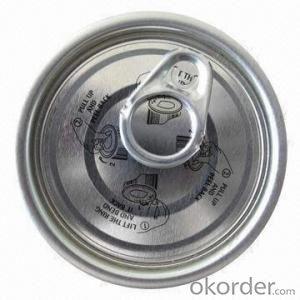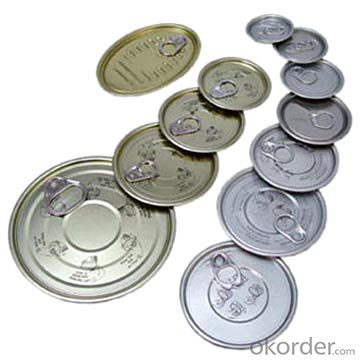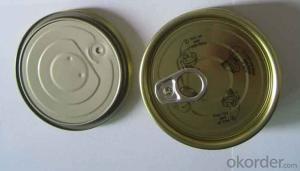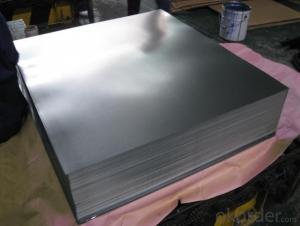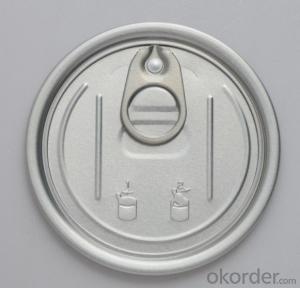Tinplate Can Lid 401#, Sardine Tuna Fish Use,Top Quality
- Loading Port:
- China main port
- Payment Terms:
- TT OR LC
- Min Order Qty:
- 500000 pc
- Supply Capability:
- 10000000 pc/month
OKorder Service Pledge
OKorder Financial Service
You Might Also Like
Brief Details
Material:Tinplate
Type: Easy Open End, full open
Usage: Cans
Feature: Canned food
Custom Order: Accept
Model Number: 401# (98.9mm), 401#
Metal Type: Tinplate
Dia: 98.9mm
Packing: paper tube
Specifications
tuna fish can
1.Tinplate 401#
2.Dia:98.9mm
3.Full open
Name | tuna fish can |
Item No. | 401# |
Shape/type | Round |
Size(mm) | Dia 98.9 |
Coating | White porcelain |
Material | Tinplate |
Pcs/20 GP’ | 950,000 Customize packing: as clients’ requests. |
Features | 1.Used for packaging of tomato paste,jam,salad…etc. 2.Have illustration printing on the lid. 3.Coating can be according to the customer required. |
Our packing
We could offer package as customers require, by carton or by wooden pallet.

FAQ
1.Q: What is the material of EOE?
We can offer both tinplate and aluminum material made EOE;
2.Q:Could you offer samples for our testing?
YES, we could offer sampler for free if needed;
3. Q:Can you make new mold with customized size I need?
YES, We can make mold for you if reach some qty.
4. Q: Which country your EOE has been exported to?
We have exported to more than 30 countries, such as UAE, Oman, Kuwait, Pakistan etc.
- Q: Can tinplate be used for packaging electronic devices?
- Yes, tinplate can be used for packaging electronic devices. Tinplate is a commonly used material for packaging due to its durability, corrosion resistance, and ability to protect against external factors such as moisture and oxidation. It provides a secure and protective housing for electronic devices, ensuring their safe transportation and storage. Additionally, tinplate can be easily customized and printed on, allowing for branding and product information to be displayed on the packaging.
- Q: How does tinplate contribute to the overall portability of packaging?
- Tinplate contributes to the overall portability of packaging by being lightweight and durable, making it easy to transport and handle. It also provides excellent protection against external elements such as moisture, light, and air, ensuring the contents remain intact during transit. Additionally, tinplate's compact and stackable nature allows for efficient storage and maximizes space utilization, further enhancing portability.
- Q: How long does tinplate last?
- Tinplate can last for several decades if properly maintained and protected from corrosion.
- Q: Can tinplate packaging be used for personal care products?
- Yes, tinplate packaging can be used for personal care products. Tinplate is a suitable material choice for packaging personal care products such as lotions, creams, and cosmetics due to its durability, resistance to corrosion, and ability to protect the contents from external factors such as light and moisture. Additionally, tinplate packaging can be easily customized and decorated to enhance the product's appeal.
- Q: What are the main challenges in tinplate welding and soldering?
- Some of the main challenges in tinplate welding and soldering include ensuring proper surface preparation to achieve good adhesion, dealing with the thin gauge of tinplate which can make it more prone to warping or burning, and finding suitable fluxes and solder alloys that can effectively bond with tinplate due to its unique properties. Additionally, the presence of tin oxide on the surface of tinplate can hinder the formation of strong welds or solder joints, requiring special techniques or treatments to address this issue.
- Q: How does tinplate compare to other packaging materials in terms of sustainability?
- Tinplate is considered to be a highly sustainable packaging material when compared to others. It is infinitely recyclable without losing its properties, making it a preferred choice for many industries. Tinplate also has a lower carbon footprint and energy consumption during its production compared to other packaging materials like plastic or glass. Additionally, tinplate offers excellent protection and preservation qualities, extending the shelf life of products and reducing food waste. Overall, tinplate stands out as a more environmentally friendly option in terms of sustainability in packaging.
- Q: Both tinplate and stainless steel have corrosion protection
- Stainless steel is added in the iron, Cr, Ni and other corrosion-resistant materials, is fundamentally changed the anti-corrosion properties of materials.
- Q: What are the main challenges in tinplate canning process?
- The main challenges in tinplate canning process include ensuring proper sealing of cans to prevent leakage, maintaining consistency in can dimensions and shape, preventing contamination during the filling process, and ensuring efficient and cost-effective production while meeting quality standards. Additionally, addressing environmental concerns related to the disposal of tinplate waste and exploring alternative packaging materials are also significant challenges.
- Q: What is the difference between food grade tinplate and ordinary chemical tinplate? What is the difference between MR material and SPCC?
- The chemical composition of MR material is more strict than that of SPCC material, and the impurities are fewCanned fish must be made of good quality MR material, which reduces the risk of canning
- Q: What are the common printing methods used on tinplate?
- The common printing methods used on tinplate include lithography, offset printing, and screen printing.
Send your message to us
Tinplate Can Lid 401#, Sardine Tuna Fish Use,Top Quality
- Loading Port:
- China main port
- Payment Terms:
- TT OR LC
- Min Order Qty:
- 500000 pc
- Supply Capability:
- 10000000 pc/month
OKorder Service Pledge
OKorder Financial Service
Similar products
Hot products
Hot Searches
Related keywords
